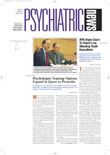The constitutionality of laws that allow states to execute offenders who committed their crimes at age 16 or 17 is the central issue in a case before the U.S. Supreme Court. Last month the APA Board of Trustees agreed to join an amicus curiae brief that argues for overturning such laws. The brief was filed with the Court on July 19.
The amicus brief, which was written by the American Society for Adolescent Psychiatry (ASAP) and contains input from APA and other organizations, argues that imaging and other data show that the brains of 16- and 17-year-olds are still developing and thus do not provide the same capability to reason, control impulses, and make certain judgments as do adult brains.
The U.S. Supreme Court has relied on similar data to declare unconstitutional the execution of mentally retarded individuals and youth under age 16—the former in its 2002 Atkins v. Virginia decision (Psychiatric News, July 19, 2002) and the latter in its 1988 ruling in Thompson v. Oklahoma.
In a 1989 ruling, the Court decided in Stanford v. Kentucky that the reasoning and the national consensus that led it to bar execution of youngsters in Thompson was not compelling enough to apply to 16- and 17-year-olds. Though, as Jeffrey Metzner, M.D., chair of APA's Committee on Judicial Action, noted, “There is nothing magical about age 16” that should render adolescents at this age eligible for a death penalty while those aged 15 are exempt.
In the current case, Donald P. Roper v. Christopher Simmons, Roper, superintendent of a Missouri prison, and other state officials are appealing a Missouri Supreme Court ruling that overturned a death sentence imposed on Simmons, who was 17 at the time he and a 15-year-old friend broke into a woman's house, robbed her, and then, after taping her eyes and mouth, threw her into a river from a railroad trestle.
Simmons had discussed with friends their intention to commit the crimes and told them he and his companion would get away with it because they were juveniles. A jury sentenced Simmons to be executed, but the Missouri Supreme Court negated the sentence citing his age and the U.S. Supreme Court's reasoning in Atkins as grounds for setting aside the death sentence. It instead sentenced him to life in prison without the possibility of parole.
The Missouri Supreme Court stated that the issues of reasoning and judgment capacity in teens younger than age 18, based on evidence provided by experts, pointed to the need to extend the issues that determined Atkins to 16- and 17-year-olds who commit capital crimes.
In the brief, APA and the other amici emphasize that sophisticated brain-research techniques have shown anatomical factors in teenagers that render them less able to make mature judgments, assess risk, and appreciate potential consequences of their actions.
“Adolescents, even at the age of 16 or 17, are more impulsive than adults. They underestimate risks and overvalue short-term benefits. They are more susceptible to stress, more emotionally volatile, and less capable of controlling their emotions. In short, adolescents cannot be expected to act with the same control or foresight as adults,” the brief points out.
“Adolescent brains are more active in regions related to aggression, anger, and fear, and less active in regions related to impulse control, risk assessment, and moral reasoning than adult brains,” the brief explains. It goes into detail about the role of brain regions such as the frontal lobe and the amygdala in controlling behavior and emotions. And the regions associated with impulse control and risk assessment are the last to develop, not reaching maturity until after late adolescence.
The brief also emphasizes that the life many adolescents endured before they were arrested can compromise their functioning and decision-making abilities even further.
“To the extent that adolescents who commit capital offenses suffer from serious psychological disturbances that exacerbate the already existing vulnerabilities of youth, they can be expected to function at substandard levels,” APA and the other amici said.
These psychological issues can often be traced to growing up in dysfunctional families, witnessing or being victims of violence, or suffering a brain trauma.
Teenagers who have experienced these severe stressors “cannot be presumed to operate even at standard levels for adolescents,” the brief emphasizes. It also cites research studies that have found that adolescents sentenced to death for capital crimes are more likely to have endured these harmful experiences than other adolescent offenders.
The amicus brief's final argument is that executing 16- and 17-year-old offenders fails to serve the goal of the death penalty— to punish as severely as possible the calculating, cold-blooded, adult murderer. Putting these teens to death “is to hold them accountable not just for their acts, but also for the immaturity of their neural anatomy and psychological development,” it states. This puts such executions in the category of cruel and unusual punishment and thus violates the U.S. Constitution's Eighth Amendment ban on such practices, as the Missouri Supreme Court ruled.
Metzner pointed out that the brief avoids comments on the death penalty as social policy or a moral issue, concentrating instead on the science on which APA has expertise to offer the Court.
As of July, 19 states still allowed execution as a sentence for 16- or 17-year-olds— 14 states allowed 16-year-olds to be executed, and five permitted it only for those aged 17 or older.
In addition to APA and ASAP, the American Medical Association, American Academy of Child and Adolescent Psychiatry, American Academy of Psychiatry and the Law, and National Mental Health Association have signed onto the amicus brief.
The Court is expected to hear oral arguments in Roper v. Simmons during its next term, which begins on the first Monday of October.
